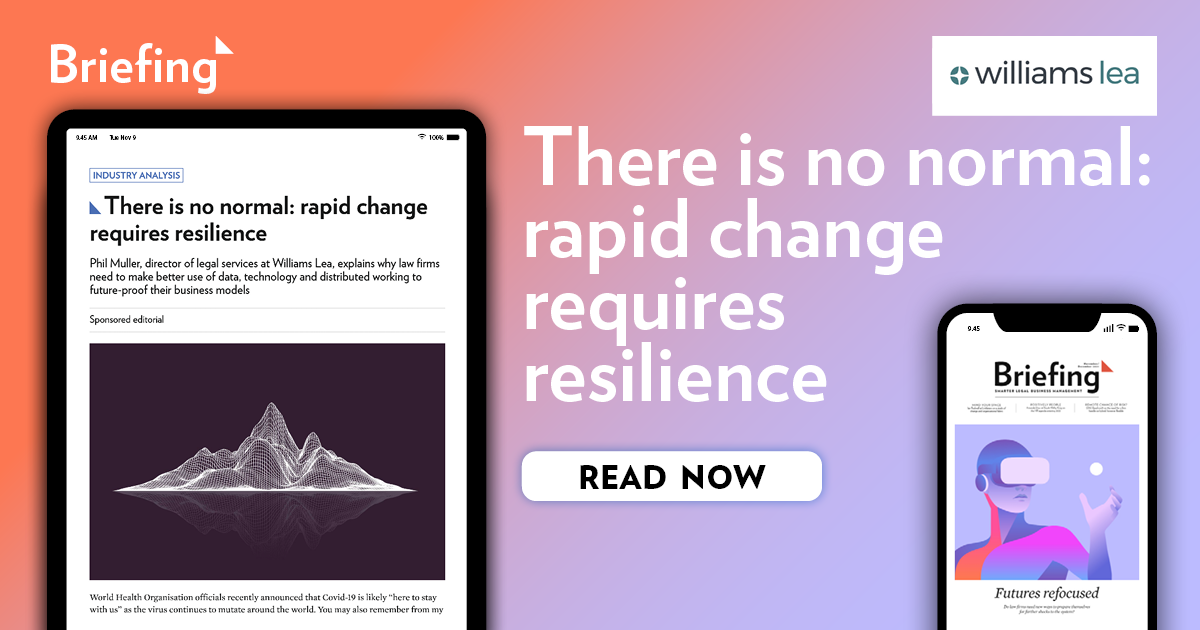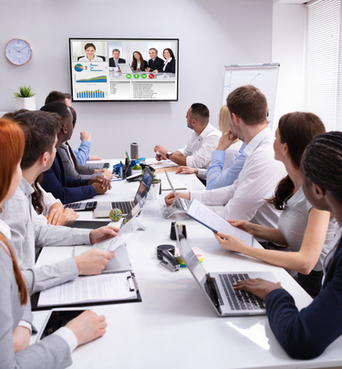December 03, 2021
This article was originally published in the November 2021 issue of Briefing Magazine
Phil Muller, director of legal services at Williams Lea, explains why law firms need to make better use of data, technology and distributed working to future-proof their business models.
World Health Organization officials recently announced that Covid-19 is likely “here to stay with us” as the virus continues to mutate around the world. You may also remember from my article in the February issue of Briefing that we polled over 400 law firm leaders, and 79% told us that the biggest impact of the pandemic for the profession was greater acceptance of new processes, technology and ways to work.
This is a fact that still resonates as the virus’s disruptive impact drags on for longer than many of us like – and there’s no denying it has radically changed the way we live and work. As governments and companies grapple with establishing initiatives to bring workers back to the office safely, Covid-19 has elevated the importance of strengthening future business strategies by integrating greater resilience into work models.
The new normal is one of constant change, and constant change requires greater flexibility. Looking beyond the pandemic, here are some key steps that law firms can take to maintain business continuity and mitigate the impact of future potentially world-altering events.
Use data in the right way to drive decision-making
Many law firms are storing massive amounts of data, yet struggle to know how to use it in the right way. This is partly due to a lack of adequate platforms that can generate insights to help leaders make informed business decisions. To drive decision-making and effective business decisions without trawling through mountains of data and suffering “paralysis by analysis,” we need quick access to data reporting. Data collection and measurement is a broad subject as it can be applied to any aspect of a law firm, but for business resilience it’s important to focus on the data that can track, measure and enhance operations. For example, technology platforms that pull data in and create reporting dashboards for real-time insight into tasks, speed to delivery, hours worked and work quality can help leaders to make the right decisions about capacity, resource utilization and efficiency. This insight helps operational leaders to stay on top of what’s going on, whether staff are in the office or remote working.
Think less about physical location and more about distributed working
The pandemic forced law firms to transform their processes rapidly and bypass restrictive policies to keep work going. For example, there was lifting of restrictions on keeping systems and networks solely behind in-office corporate firewalls (on-prem) so employees could complete their assignments at home and access corporate systems without physical office presence. Some firms have embraced this as the way forward, and some are determined to bring people back to the office. Either way, the expectation among law firm leaders now is that if things need to change again, those changes need to take place quickly. Now that the ability to keep the wheels turning with many staff working remotely has been proven, physical location is becoming less relevant. It’s a shift that will also have significance for talent acquisition as hiring managers consider filling roles with individuals who aren’t necessarily located near headquarters. Law firms that bring flexibility by allowing distributed working, whether through sourcing talent in various locations, or by outsourcing to third parties located elsewhere, will cultivate an agile workforce that’s able to maintain business continuity through times of instability and unforeseen events.
Adopt adaptive technology to give greater digital equality in a hybrid world
“Hybrid working” has been a well-used buzzword of 2021, but another word gaining much traction is ‘intentionality’. This refers to creating a workplace that empowers employees to use hybrid working in the most effective way possible. Firms that invest in technology to help workers seamlessly interact with one another, both physically and digitally, will create a workplace that encourages digital equality. This ensures indistinguishable experiences for both remote and office-based employees, facilitating engaging, collaborative and effective experiences for a hybrid workforce.
Conclusion: the new normal is constant transformation
The pandemic was a tipping-point that led to many law firms achieving what they never thought possible in such a short time. This new normal of rapid transformation has created an environment that’s intolerant of the previous slower pace of change. Law firm leaders must strike a balance between rapid change and too much change. This requires continuing to innovate and think outside the box, with a focus on flexibility and elasticity that brings energy and stronger engagement to the workforce, while avoiding workers suffering from “change fatigue.” Harnessing data, distributed working and integrating the right technology will give your firm the greater elasticity it needs for a resilient work model.
To read the November 2021 issue of Briefing Magazine, click here .
Share
How we help
-
Accelerate digital transformation
Building a digital-first support model through innovative tech-led processes
-
Connect virtual and onsite teams
Enabling a hybrid workforce through rightshore support models
-
Access global support capabilities
Providing 24/7, follow-the-sun support that delivers consistent, uninterrupted service
Insights
Case
Studies
It is a long established fact that a reader













